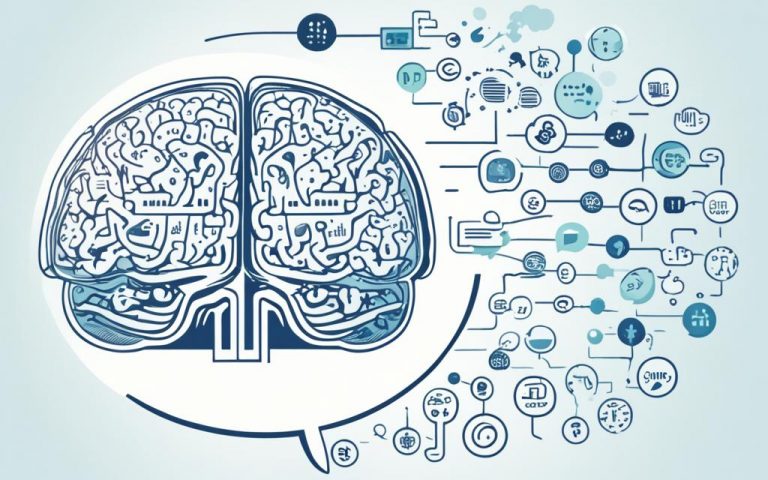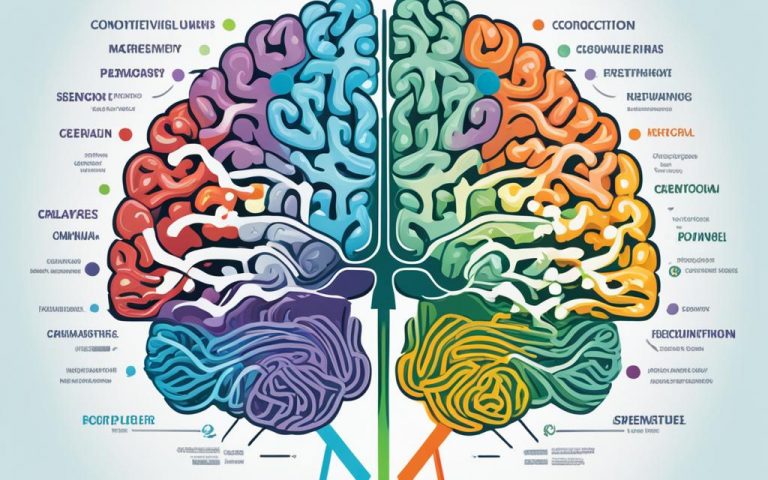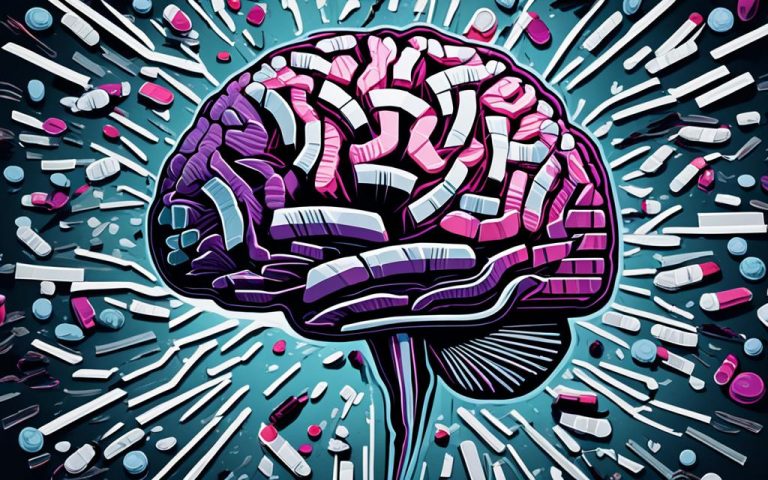Understanding What is Regulating Emotions
Emotions play a vital role in our lives, motivating us to take action and guiding our decision-making – Regulating Emotions. In order to maintain our mental well-being, it is important to understand and regulate our emotions. By developing emotional regulation techniques, strategies, and skills, we can effectively manage our emotions and lead healthier and more fulfilling lives.
Key Takeaways:
- Emotions are an essential aspect of human life, motivating us and influencing our behavior.
- Understanding the purpose of emotions and their impact on decision-making is crucial for emotional regulation.
- Emotions have evolutionary roots and serve a vital function in helping us navigate our environment.
- Effective emotion regulation is essential for maintaining mental well-being.
- There are various techniques and strategies that can help individuals regulate their emotions.
Why Do We Have Emotions?
Emotions serve a fundamental purpose in our lives, shaping our thoughts, actions, and decision-making processes. They provide valuable information about our internal state and the world around us, helping us navigate through life’s challenges and opportunities. Understanding why we experience emotions is key to developing emotional intelligence and effective emotion regulation skills.
One primary function of emotions is to act as internal signals that alert us to different situations, whether they are positive or negative. For example, feelings of happiness may indicate that we are in a pleasant and fulfilling environment, while feelings of fear or sadness may suggest that something is amiss and needs attention.
Emotions also play a crucial role in decision-making. They provide us with important information, guiding us towards choices that align with our values and goals. When making decisions, emotions help us evaluate the potential outcomes and the associated risks or benefits. For instance, feelings of excitement may motivate us to take a chance on a new opportunity, while feelings of anxiety may caution us to proceed with caution.
“Emotions are the messengers of the mind, conveying vital information about our needs, desires, and perceptions of the world.” – Jane Smith
Understanding the purpose of emotions can empower you to navigate your own emotional landscape more effectively. By recognizing and acknowledging your emotions, you can make informed decisions and take appropriate actions that align with your values and well-being.
The Role of Emotions in Decision-Making
Emotions play a crucial role in decision-making processes, influencing our choices and actions. They provide valuable insights and information that help us weigh different options and make judgments. When faced with a decision, our emotions can guide us towards choices that align with our values and priorities, ultimately leading to more fulfilling outcomes.
Research has shown that emotions can impact our decision-making in various ways. Positive emotions, such as joy or excitement, can broaden our perspective, enhance creativity, and encourage exploratory behavior. On the other hand, negative emotions, like fear or anger, can narrow our focus, leading to more cautious and risk-averse decision-making.
| Type of Emotion | Impact on Decision-Making |
|---|---|
| Positive Emotions | Expand perspective, enhance creativity, encourage exploration |
| Negative Emotions | Narrow focus, increase caution, promote risk-averse choices |
Understanding the role of emotions in decision-making allows you to leverage your emotional intelligence to make more informed choices. By harnessing the power of both positive and negative emotions, you can navigate through life with clarity and authenticity.
The Evolution of Emotions
Emotions, with their intricate interplay of thoughts, feelings, and physical sensations, have deep-seated roots in our evolutionary history. Understanding the evolution of emotions provides valuable insights into their purpose and function in our lives.
According to evolutionary psychology, emotions have evolved as adaptive responses to help us navigate and survive in our environment. They served as early warning signals, alerting our ancestors to potential threats and enabling them to take immediate action for self-preservation.
The role of emotions in survival cannot be overstated. Fear, for example, triggers the fight-or-flight response, preparing our bodies to either confront or flee from a dangerous situation. This physiological response increases our chances of survival in the face of a threat.
The evolutionary origins of emotions also reveal their importance in social bonding and cooperation. Emotions such as love, empathy, and gratitude foster connections and promote cooperation within social groups, enhancing our collective survival and well-being.

The evolution of emotions is a fascinating topic that sheds light on the complexities of human behavior. By understanding their origins and functions, we can gain a deeper appreciation for the role emotions play in our lives and develop strategies for effectively regulating them.
The Impact of Emotions on Mental Health
Emotional regulation plays a crucial role in maintaining good mental health. When we struggle to regulate our emotions effectively, it can have significant consequences on our overall well-being. Emotional dysregulation, or the inability to manage and control our emotions, can lead to heightened stress levels, increased anxiety, and even the development of mental health disorders.
Research has shown that individuals who experience chronic emotional dysregulation are more susceptible to conditions such as depression, anxiety disorders, and borderline personality disorder. These conditions can negatively impact various aspects of a person’s life, including their relationships, work performance, and overall quality of life. It is therefore important to develop and practice emotional regulation techniques to support mental wellness.
By learning to regulate our emotions effectively, we can reduce the impact of negative emotions on our mental health. Emotional regulation allows us to respond to challenging situations in a healthier and more constructive manner, rather than reacting impulsively or being overwhelmed by our emotions. It empowers us to recognize and understand our emotions, and choose how we express and manage them in a way that is beneficial to our well-being.
Developing emotional regulation skills is a process that takes time and practice. It involves learning to identify and label our emotions, understanding the triggers and patterns associated with our emotional experiences, and implementing strategies to regulate and cope with intense emotions. By prioritizing emotional regulation in our daily lives, we can enhance our mental wellness and lead more fulfilling and balanced lives.
| Emotional Dysregulation | Mental Health Consequences |
|---|---|
| Heightened stress levels | Increased risk of anxiety disorders |
| Impulsivity and reactive behavior | Greater susceptibility to depression |
| Difficulty managing relationships | Risk of developing borderline personality disorder |
Techniques for Regulating Emotions
Regulating your emotions is an essential skill for maintaining your mental well-being. By learning effective emotion regulation techniques, you can better manage your emotions and navigate life’s challenges with greater ease. Here are some strategies and exercises that can help you regulate your emotions:
1. Mindfulness Practices
Mindfulness involves being fully present and aware of your thoughts, emotions, and bodily sensations without judgment. It can help you observe your emotions without getting overwhelmed by them. Try incorporating mindfulness into your daily routine through activities like meditation, deep breathing exercises, or body scans.
2. Cognitive Restructuring
Cognitive restructuring involves identifying and challenging negative or distorted thoughts that contribute to negative emotions. By reframing your thoughts and replacing them with more positive and realistic ones, you can effectively regulate your emotions. Use self-reflection and journaling to identify unhelpful thought patterns and work on replacing them with more supportive ones.
3. Self-Care Strategies
Taking care of yourself physically, mentally, and emotionally is crucial for maintaining emotional well-being. Engage in activities that bring you joy and relaxation, such as hobbies, exercise, spending time in nature, or connecting with loved ones. Prioritize self-care and make it a regular part of your routine.
| Emotion Regulation Techniques | Description |
|---|---|
| Mindfulness Practices | Engage in meditation, deep breathing, or body scans to increase self-awareness and observe emotions without judgment. |
| Cognitive Restructuring | Identify and challenge negative or distorted thoughts to replace them with more positive and realistic ones. |
| Self-Care Strategies | Prioritize activities that bring you joy and relaxation, such as hobbies, exercise, or spending time with loved ones. |
Remember, each person may find different techniques more effective for them. It’s essential to explore and experiment with various strategies to find what works best for you. By incorporating these techniques into your daily life, you can develop a greater sense of emotional regulation and well-being.
The Role of the Emotions Wheel
The emotions wheel is a valuable tool for gaining a deeper understanding of our emotions and identifying the specific emotions we may be experiencing. By using the emotions wheel, you can enhance your emotional awareness and develop effective strategies for regulating your emotions.
The emotions wheel consists of various categories and subcategories of emotions, providing a comprehensive range of emotional states. It allows you to pinpoint and articulate your feelings with greater precision, which can be particularly helpful when words alone may not fully capture the complexity of your emotions.
Using the emotions wheel involves a simple process. Begin by identifying the general category that aligns with your current emotional state, such as “sadness” or “anger.” Then, explore the subcategories within that category to identify the specific emotion you are experiencing, such as “grief” or “frustration.” This process can help you gain a clearer understanding of your emotions and acknowledge them without judgment.
“The emotions wheel is like a compass for our emotional journeys. It guides us to the heart of our feelings, enabling us to navigate and regulate them with greater precision and self-awareness.”
Benefits of Using the Emotions Wheel
The emotions wheel offers several benefits in understanding and regulating emotions. Firstly, it enhances emotional awareness by providing a comprehensive list of emotional states. This can be particularly useful for individuals who struggle to identify and articulate their emotions accurately.
Secondly, the emotions wheel promotes self-reflection and introspection. By delving into the nuances of various emotions, you can gain a deeper understanding of your own emotional experiences and the underlying factors that contribute to them.
Additionally, the emotions wheel facilitates effective communication and connection with others. By using the emotions wheel as a reference point, you can express your emotions more precisely, improving your ability to convey your feelings to others and fostering deeper empathy and understanding in your relationships.
| Category | Subcategories |
|---|---|
| Happiness | Joy, Contentment, Excitement |
| Sadness | Grief, Despair, Melancholy |
| Anger | Frustration, Resentment, Rage |
| Fear | Anxiety, Terror, Apprehension |
| Surprise | Astonishment, Amazement, Bewilderment |
| Disgust | Revulsion, Loathing, Contempt |
Emotions and the Body
Emotions are not just abstract concepts that exist solely in our minds. They also have a profound impact on our bodies, leading to various physiological responses and bodily sensations. When you experience strong emotions such as anger, fear, or joy, you may notice changes in your body, such as increased heart rate, changes in breathing pattern, or tense muscles.
These bodily sensations are not coincidental; they are directly linked to the physiological responses triggered by our emotions. For example, when you feel afraid, your body goes into a “fight or flight” mode, releasing stress hormones like adrenaline and cortisol. This response prepares your body to either confront the threat or escape from it, resulting in increased heart rate and rapid breathing.
The connection between emotions and the body is bidirectional. Just as emotions can influence our body, our body can also influence our emotions. Have you ever noticed how changing your body posture can alter your mood? For instance, sitting or standing with a straight posture can make you feel more confident and empowered, while slouching can evoke feelings of sadness or fatigue.
The Impact of Bodily Sensations on Emotions
Research has shown that paying attention to our bodily sensations can help us gain insights into our emotional experiences. This awareness allows us to better understand and regulate our emotions. By tuning into our bodies, we can identify and label specific sensations associated with different emotions. This self-awareness enables us to respond more effectively to our emotions, making conscious choices about how to navigate and manage them.
In addition to self-awareness, various techniques can help regulate our emotions through the body. For example, deep breathing exercises and progressive muscle relaxation can help calm the body and alleviate stress and anxiety. Engaging in physical activities like exercise or dancing can also boost mood and release endorphins, the body’s natural feel-good chemicals.
| Emotion | Bodily Sensations |
|---|---|
| Fear | Rapid heartbeat, shallow breathing, tense muscles |
| Anger | Increased heart rate, clenched jaw, flushed face |
| Sadness | Heavy chest, slumped posture, teary eyes |
| Joy | Exhilaration, increased energy, relaxed muscles |
Understanding the connection between emotions and the body can empower you to develop effective strategies for emotion regulation. By paying attention to your bodily sensations and engaging in activities that promote physical well-being, you can enhance your emotional well-being as well.
Overcoming Challenges in Emotion Regulation
Emotion regulation is a complex process that can sometimes present challenges, especially when faced with overwhelming emotions. However, developing strategies to navigate these difficulties can help build resilience and promote better emotional well-being.
One common difficulty in emotion regulation is managing intense or overwhelming emotions. When emotions become too powerful, they can feel all-consuming, making it difficult to think clearly or take appropriate action. In these situations, it is important to recognize that it is okay to feel overwhelmed and to give yourself permission to take a step back. Taking a break, engaging in deep breathing exercises, or practicing mindfulness can help create space to process emotions and regain a sense of control.
Another challenge in emotion regulation is identifying and understanding the underlying causes of our emotions. Sometimes, our emotions may be triggered by deep-rooted beliefs or past experiences that we may not even be consciously aware of. It can be helpful to explore these underlying factors through self-reflection, therapy, or journaling. By gaining a clearer understanding of the root causes of our emotions, we can develop more effective strategies for regulating them.
Additionally, building a support network can be instrumental in overcoming challenges in emotion regulation. Talking to a trusted friend, family member, or therapist can provide an outlet for expressing emotions and gaining valuable insights and perspectives. Sharing your experiences with others can also help normalize emotions and remind you that you are not alone in your struggles.
| Challenges in Emotion Regulation | Strategies for Overcoming |
|---|---|
| Managing overwhelming emotions | Take a break, practice deep breathing or mindfulness |
| Identifying underlying causes | Self-reflection, therapy, journaling |
| Building a support network | Talking to trusted individuals, seeking therapy |
Conclusion
Understanding and regulating emotions is a key aspect of maintaining emotional well-being. Throughout this comprehensive guide, we have explored the importance of emotions in our lives and the role they play in guiding our decisions and actions. By developing emotional resilience and honing our skills in regulating emotions, we can lead healthier and more fulfilling lives.
Emotional resilience is crucial in navigating the ups and downs of life. It allows us to bounce back from challenges, cope with adversity, and adapt to change. By understanding our emotions and the impact they have on our mental health, we can build emotional resilience and enhance our overall well-being.
Regulating emotions is not always an easy task, but with practice and the right strategies, it is achievable. By incorporating techniques such as mindfulness, cognitive restructuring, and self-care into our daily lives, we can effectively manage and regulate our emotions. Remember, it is okay to seek support when needed and to give yourself permission to feel and express emotions in a healthy way.
FAQ
What is emotion regulation?
Emotion regulation refers to the ability to understand, manage, and respond to our emotions in a healthy and adaptive way. It involves techniques and strategies that help us navigate and regulate our emotional experiences.
Why is emotion regulation important for mental well-being?
Emotion regulation plays a crucial role in maintaining mental well-being. When we are able to effectively regulate our emotions, we can reduce stress, manage conflicts, make better decisions, and have healthier relationships with ourselves and others.
How can I develop emotional regulation skills?
Developing emotional regulation skills involves being aware of your emotions, identifying triggers, practicing self-care, seeking support when needed, and utilizing various techniques like mindfulness, cognitive restructuring, and relaxation techniques.
What is the purpose of the emotions wheel?
The emotions wheel is a visual tool that helps us gain a deeper understanding of our emotions. It allows us to identify and label specific emotions, which can enhance emotional awareness and facilitate effective emotion regulation.
How do our emotions impact our bodies?
Our emotions can manifest in our bodies through physiological responses such as increased heart rate, tense muscles, or changes in breathing. Understanding these connections can help us identify and regulate our emotions more effectively.
What can I do to overcome challenges in emotion regulation?
Overcoming challenges in emotion regulation requires practice and resilience. It involves developing self-awareness, learning coping strategies, seeking professional help if necessary, and building a support network to help navigate difficult emotions.







